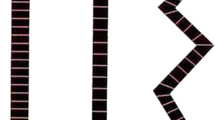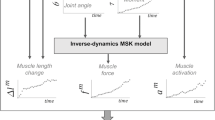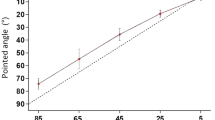Abstract
Viscoelastic properties play an important role in posture and movement. Such properties arise from muscle mechanics and from stretch-reflex actions. We describe experiments designed to characterize both linear and nonlinear elastic and viscous properties of the wrist motor servo in human subjects. First, we describe a trial comparison method for the identification of reflex responses that are unmodified by triggered reaction-time movements. Elastic properties were studied by applying step changes in load force that stretched or released the wrist flexor and extensor muscles. The properties were basically spring-like, but there was a short-range enhancement of stiffness that gave rise to a prominent hysteresis. Viscous properties were studied by applying ramp stretches at different velocities. Both EMG and force responses showed a weak fractional-power dependence on velocity similar to that described recently for muscle spindle receptors. Consideration is given to the possible advantages of this type of nonlinear feedback in the damping of postural responses and movements.
Similar content being viewed by others
References
Allum, J.H.J., K-H Mauritz, and H. Vogele. The mechanical effectiveness of short latency reflexes in human triceps surae muscles revealed by ischaemia and vibration.Exp. Brain Res. 48:153–156, 1982.
Allum, J.H.J., K-H Mauritz, and H. Vogele. Stiffness regulation provided by short latency reflexes in human triceps surae muscles.Brain Res. 234:159–164, 1982.
Asatryan, D.G. and A.G. Feldman. Functional tuning of the nervous system with control of movement or maintenance of posture. I. Mechanographic analysis of the work of the joint on execution of a postural task.Biophys. USSR 10:925–935, 1965.
Bizzi, E., P. Dev, P. Morasso, and A. Polit. Effect of load disturbances during centrally initiated movements.J. Neurophysiol. 41:542–556, 1978.
Bizzi, E., A. Polit, and P. Morasso. Mechanisms underlying achievement of final head position.J. Neurophysiol. 39:435–444, 1976.
Cordo, P.J. and W.Z. Rymer. Contributions of motor-unit recruitment and rate modulation to compensation for muscle yielding.J. Neurophysiol. 47:797–809, 1982.
Crago, P.E., J.C. Houk, and Z. Hasan. Regulatory actions of human stretch reflex.J. Neurophysiol. 39:925–935, 1976.
Feldman, A.G. Functional tuning of the nervous system during control of movement or maintenance of a steady posture. III. Mechanographic analysis of the execution by man of the simplest motor tasks.Biophys. USSR 11:766–775, 1966.
Hasan, Z. and J.C. Houk. Transition in sensitivity of spindle receptors that occurs when muscle is stretched more than a fraction of a millimeter.J. Neurophysiol. 37:673–689, 1975.
Hoffer, J.A. and S. Andreassen. Regulation of soleus muscle stiffness in premammillary cats: Intrinsic and reflex components.J. Neurophysiol. 45:267–285, 1981.
Houk, J.C. Participation of reflex mechanisms and reaction-time processes in the compensatory adjustments to mechanical disturbances. InCerebral Motor Control in Man: Long Loop Mechanisms, edited by J.E. Desmedt. Basel: Karger, 1978, pp. 193–225.
Houk, J.C. Afferent mechanisms mediating autogenetic reflexes. InBrain Mechanisms and Perceptual Awareness, edited by O. Pompeiano and C.J. Marsan, New York: Raven Press, 1981, pp. 167–181.
Houk, J.C., P.E. Crago, and W.Z. Rymer. Function of the spindle dynamic response in stiffness regulation-a predictive mechanism provided by nonlinear feedback. InMuscle Receptors and Movement, edited by A. Taylor and A. Prochazka. London: Macmillan, 1981, pp. 299–309.
Houk, J.C., D.A. Harris, and Z. Hasan. Non-linear behaviour of spindle receptors. InControl of Posture and Locomotion, edited by R.B. Stein, K.B. Person, R.S. Smith, and J.B. Redford. New York: Plenum Publishing Corp., 1973, pp. 147–163.
Houk, J.C. and W.Z. Rymer. Neural control of muscle length and tension. InHandbook of Physiology. Section 1: The Nervous System. Volume 2: Motor Control, edited by S.R. Geiger. Bethesda: American Physiological Society, 1981, pp. 257–323.
Houk, J.C., W.Z. Rymer, and P. Crago. Dependence of the dynamic response of muscle receptors on muscle length and velocity.J. Neurophysiol. 46:143–166, 1981.
Jaeger, R.J., G.L. Gottleib, and G.C. Agarwal. Myoelectric responses at flexors and extensors of human wrist to step torque perturbations.J. Neurophysiol. 48:388–402, 1982.
Joyce, G.C., P.M.H. Rack, and D.R. Westbury. The mechanical properties of cat soleus muscle during controlled lengthening and shortening movements.J. Physiol. London 204:461–474, 1969.
Kelso, J.A.S. and K.G. Holt. Exploring a vibratory systems analysis of human movement production.J. Neurophysiol. 43:1183–1196, 1980.
Laquaniti, F., F. Licata, and J.F. Soechting. The mechanical behavior of the human forearm in response to transient perturbations.Biol. Cybern. 44:35–46, 1982.
Matthews, P.B.C. Evidence that the secondary as well as the primary endings of the muscle spindles may be responsible for the tonic stretch reflex of the decerebrate cat.J. Physiol. London 204:365–393, 1969.
Newell, K.M. and J.C. Houk. Speed and accuracy of compensatory responses to limb disturbances.J. Exp. Psych. 9:58–74, 1983.
Nichols, T.R. Soleus muscle stiffness and its reflex control. Ph.D. thesis. Cambridge, Massachusetts: Harvard University, 1974.
Nichols, T.R. and J.C. Houk. The improvement in linearity and the regulation of stiffness that results from the actions of the stretch reflex.J. Neurophysiol. 39:119–142, 1976.
Rack, P.M.H. and D.R. Westbury. The short range stiffness of active mammalian muscle and its effect on mechanical properties.J. Physiol. London 240:331–350, 1974.
Roberts, T.D.M. Rhythmic excitations of a stretch reflex, revealing (a) hysteresis and (b) a difference between the responses to pulling and stretching.Q. J. Exp. Physiol. 48:328–345, 1963.
Rymer, W.Z. and Z. Hasan. Absence of force-feedback in soleus muscle of the decerebrate cat.Brain Res. 184:203–209, 1980.
Shefchyk, S.J., R.B. Stein, and L.M. Jordan. How is the monosynaptic reflex modulated during the step cycle?Soc. for Neurosci. Abstr. 8:165, 1982.
Stein, R.B. and P. Bawa. Reflex responses of human soleus muscle to small perturbations.J. Neurophysiol. 39:1105–1116, 1976.
Author information
Authors and Affiliations
Rights and permissions
About this article
Cite this article
Gielen, C.C.A.M., Houk, J.C., Marcus, S.L. et al. Viscoelastic properties of the wrist motor servo in man. Ann Biomed Eng 12, 599–620 (1984). https://doi.org/10.1007/BF02371452
Issue Date:
DOI: https://doi.org/10.1007/BF02371452




